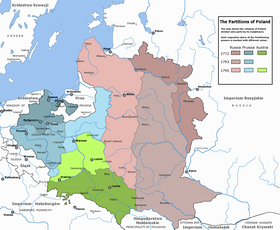Austrian Partition
| The Austrian Partition | |
|---|---|
| The Commonwealth | |
 The Polish–Lithuanian Commonwealth in 1772 | |
| Elimination | |
 The three partitions of the Polish–Lithuanian Commonwealth. The Russian Partition (red), the Austrian Partition (green), and the Prussian Partition (blue) |
The Austrian Partition (Polish: zabór austriacki) comprises the former territories of the Polish–Lithuanian Commonwealth acquired by the Habsburg monarchy during the Partitions of Poland in the late 18th century. The three partitions were conducted jointly by the Russian Empire, the Kingdom of Prussia and Habsburg Austria, resulting in the complete elimination of the Polish Crown. Austria acquired Polish lands during the First Partition of 1772, and Third Partition of Poland in 1795.[1] In the end, the Austrian sector encompassed the second-largest share of the Commonwealth's population after Russia;[note 1] over 2.65 million people living on 128,900 km2 (49,800 sq mi) of land constituting the formerly south-central part of the Republic.[3]
History
The territories acquired by
Society
For most of the 19th century, the Austrian government made little or no concessions to their Polish constituents,[5] their attitude being that a "patriot was a traitor – unless he was a patriot for the [Austrian] Emperor."[6] However, by the early 20th century – just before the outbreak of World War I and the collapse of Austria-Hungary – out of the three partitions, the Austrian one had the most local autonomy.[7] The local government called the Governorate Commission (Polish: Komisja Gubernialna) had considerable influence locally, Polish was accepted as the official regional language on Polish soil, and used in schools; Polish organizations had some freedom to operate, and Polish parties could formally participate in Austro-Hungarian politics of the empire.[7]
Austria-Hungary also de facto encouraged (the flourishing[8]) Ukrainian organizations as a divide and rule tactic.[9][10] This led to accusations by Poles that "Austria-Hungary had invented Ukrainians".[10] Ukrainians maintained schools (from elementary to higher levels)[note 2] and newspapers[note 3] in the Ukrainian language.[8][12] After 1848 Ukrainians also moved into Austrian politics with their own political parties.[8] Austria-Hungary gave Ukrainians more rights than Ukrainians living in the Russian Empire.[13] Decades after it had ceased to exist its former Ukrainian citizens had positive emotions about Austria-Hungary.[13]
Economy
On the other hand, economically, Galicia was rather backward, and universally regarded as the poorest of the three partitions.
Administrative division
The Austrian Empire divided the former territories of the Commonwealth it obtained into:
- Kingdom of Galicia and Lodomeria – from 1772 to 1918.
- West Galicia – from 1795 to 1809
- Free City of Kraków– from 1815 to 1846
Two important and major cities of the Austrian partition were
In the first partition, Austria received the largest share of the formerly Polish population, and the second largest land share (83,000 km² and over 2.65 million people). Austria did not participate in the second partition, and in the third, it received 47,000 km² with 1.2 million people. Overall, Austria gained about 18 percent of the former Commonwealth territory (130,000 km²) and about 32 percent of the population (3.85 million people).
See also
Notes
- ^ The "Austrian sector" is a historical term used by scholars in reference to Commonwealth territories consisting of Polish heritage dating as far back as the first days of Poland's statehood.[2]
- ^ This Ukrainian education system was also in the Polish–Lithuanian Commonwealth.[9]
- ^ The first published in 1948.[10][11]
References
- ISBN 0199253404, retrieved November 24, 2012
- ISBN 9287148821. Retrieved March 26, 2013.
- ISBN 0199253390.
- ISBN 0-691-04944-0, pp. 104-5
- ISBN 0-521-55917-0, p. 129
- ^ Anatol Murad (1968). "A patriot was a traitor—unless he was a patriot for the Emperor". Franz Joseph I of Austria and His Empire (first print ed.). Ardent Media. p. 17. Retrieved November 21, 2012.
- ^ a b c d e f g h Andrzej Garlicki, Polsko-Gruziński sojusz wojskowy, Polityka: Wydanie Specjalne 2/2008, ISSN 1730-0525, p. 11-12
- ^ ISBN 0275953858(page 9)
- ^ ISBN 978-0-19-530546-3
- ^ ISBN 978-1-4426-0991-4
- ^ Jeremy Popkin, ed., Media and Revolution: Comparative Perspectives (University of Kentucky Press, 1995)
- ^ Mark von Hagen. (2007). War in a European Borderland. University of Washington Press. pg. 4
- ^ ISBN 1442640855(page 482)
- ^ David Crowley, National Style and Nation-state: Design in Poland from the Vernacular Revival to the International Style, Manchester University Press ND, 1992
ISBN 0-7190-3727-1, p. 12
- ISBN 0-415-25491-4, p. 133
Further reading
- Norman Davies: God's Playground, p. 102-119: GALICIA: The Austrian Partition (1773–1918)
